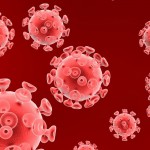 A test for HIV that is 10 times more sensitive and a fraction of the cost of current methods, has been developed by British scientists.
A test for HIV that is 10 times more sensitive and a fraction of the cost of current methods, has been developed by British scientists.
It uses nanotechnology to give a result that can be seen with the naked eye by turning a sample red or blue.
Developed by scientists at Imperial College in London, the technique offers the promise of better diagnosis and treatment in the developing world.
Research leader Molly Stevens, said: ‘Our approach affords for improved sensitivity, does not require sophisticated instrumentation and it is ten times cheaper.’
Simple and quick HIV tests that analyze saliva already exist but they can only pick up the virus when it reaches relatively high concentrations in the body.
‘We would be able to detect infection even in those cases where previous methods, such as the saliva test, were rendering a ‘false negative’ because the viral load was too low to be detected,’ Stevens said, after the research was published in the journal Nature Nanotechnology.
The test could also be reconfigured to detect other diseases, such as sepsis, Leishmaniasis, Tuberculosis and malaria, Stevens said.
Testing is not only crucial in picking up the virus that causes Aids early but also for monitoring the effectiveness of treatments.
‘Unfortunately, the existing gold standard detection methods can be too expensive to be implemented in parts of the world where resources are scarce,’ Stevens said.
Research leader: Molly Stevens said she is planning to work with not-for-profit global health organisations to distribute the new sensor
According to 2010 data from the World Health Organisation, about 23 million people living with HIV are in Sub-Saharan Africa out of a worldwide total of 34 million.
The virus is also spreading faster and killing more people in this part of the world. Sub-Saharan Arica accounted for 1.9 million new cases out of a global total of 2.7 million in the same year, and 1.2 million out of the 1.8 million deaths.
The new sensor works by testing serum, a clear watery fluid derived from blood samples, in a disposable container for the presence of an HIV biomarker called p24.
If p24 is present, even in minute concentrations, it causes the tiny gold nanoparticles to clump together in an irregular pattern that turns the solution blue. A negative result separates them into ball shapes that generate a red color.
The researchers also used the test to pick up the biomarker for Prostate Cancer called Prostate Specific Antigen, which was the target of previous work that Stevens did with collaborators at University of Vigo in Spain.
That sensor used tiny gold stars laden with antibodies that latched onto the marker in a sample and produced a silver coating that could be detected with microscopes.
Stevens and her collaborator on the new test, Roberto de la Rica, said they plan to approach not-for-profit global health organizations to help them manufacture and distribute the new sensor in low-income countries.
Source: MailOnline

















